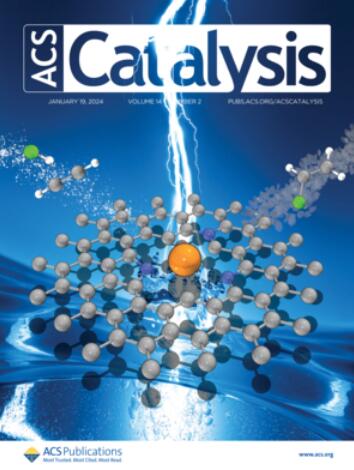Lewis Acid-Catalyzed Enantioselective (4 + 3)/Thia-(3 + 2) Cycloadditions of Bicyclobutanes and Enaminothiones: Catalyst-Directed Divergent Synthesis of Bridged Sulfur Heterocycles
IF 13.1
1区 化学
Q1 CHEMISTRY, PHYSICAL
引用次数: 0
Abstract
Despite significant advancements in the synthesis of sulfur heterocycles and bridged bicyclo[n.1.1]-bioisosteres, the straightforward construction of sulfur-containing bridged bicyclic molecules, particularly in the enantiopure form, continues to pose a considerable challenge in exploring new chemical spaces for drug discovery. We herein report regiodivergent catalyst-controlled Lewis acid-catalyzed cycloaddition reactions between bicyclobutanes (BCBs) and enaminothiones. Using a zinc catalyst, the first thia-(3 + 2) cycloaddition of BCBs was achieved with good regioselectivity and broad functional group tolerance. In contrast, reactions using a scandium Lewis acid catalyst produced valuable thiabicyclo[4.1.1]octanes (thia-BCOs) in good yield through (4 + 3) cycloaddition reactions with the same starting materials. Notably, an unprecedented Lewis acid-catalyzed asymmetric (4 + 3) cycloaddition reaction involving BCBs was explored, thereby expanding the chemical space of enantiopure BCO scaffolds. Experimental investigations coupled with density functional theory calculations provide valuable insights into the reaction pathway and elucidate the origins of enantioselectivity in the current (4 + 3) cycloaddition reaction.

Lewis酸催化的对映选择性(4 + 3)/(3 + 2)环加成:催化定向的桥接硫杂环的发散合成
尽管硫杂环和桥接双环[n.1.1]-生物异构体的合成取得了重大进展,但直接构建含硫桥接双环分子,特别是以对不纯形式,仍然对探索新的药物发现化学空间构成相当大的挑战。本文报道了区域分散催化控制的路易斯酸催化的环加成反应在双环丁烷(BCBs)和氨基硫酮之间。在锌催化剂的催化下,首次实现了bcb的thia-(3 + 2)环加成,具有良好的区域选择性和广泛的官能团耐受性。相比之下,使用钪Lewis酸催化剂的反应,在相同的起始材料下,通过(4 + 3)环加成反应,以良好的产率产生了有价值的硫代环[4.1.1]辛烷(thia-BCOs)。值得注意的是,研究人员史无前例地探索了Lewis酸催化的涉及BCO的不对称(4 + 3)环加成反应,从而扩大了对映纯BCO支架的化学空间。实验研究与密度泛函理论计算相结合,为反应途径提供了有价值的见解,并阐明了当前(4 + 3)环加成反应中对映体选择性的来源。
本文章由计算机程序翻译,如有差异,请以英文原文为准。
求助全文
约1分钟内获得全文
求助全文
来源期刊

ACS Catalysis
CHEMISTRY, PHYSICAL-
CiteScore
20.80
自引率
6.20%
发文量
1253
审稿时长
1.5 months
期刊介绍:
ACS Catalysis is an esteemed journal that publishes original research in the fields of heterogeneous catalysis, molecular catalysis, and biocatalysis. It offers broad coverage across diverse areas such as life sciences, organometallics and synthesis, photochemistry and electrochemistry, drug discovery and synthesis, materials science, environmental protection, polymer discovery and synthesis, and energy and fuels.
The scope of the journal is to showcase innovative work in various aspects of catalysis. This includes new reactions and novel synthetic approaches utilizing known catalysts, the discovery or modification of new catalysts, elucidation of catalytic mechanisms through cutting-edge investigations, practical enhancements of existing processes, as well as conceptual advances in the field. Contributions to ACS Catalysis can encompass both experimental and theoretical research focused on catalytic molecules, macromolecules, and materials that exhibit catalytic turnover.
 求助内容:
求助内容: 应助结果提醒方式:
应助结果提醒方式:


